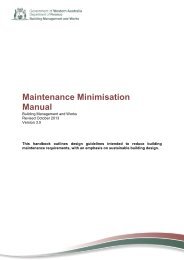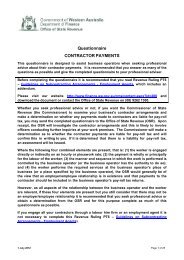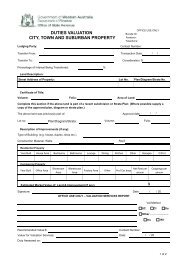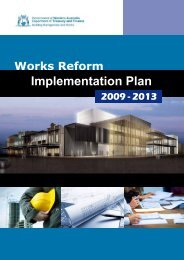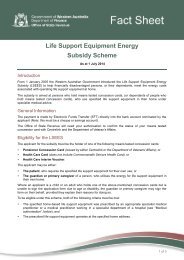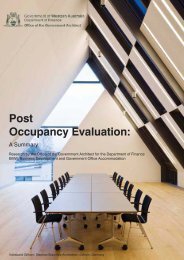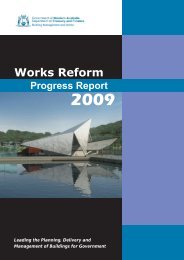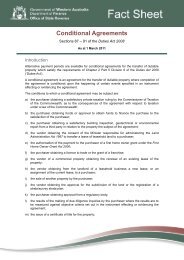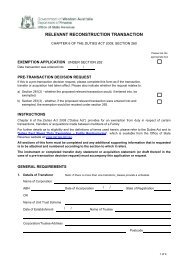Renewable Energy Handbook 2010 - Department of Finance - The ...
Renewable Energy Handbook 2010 - Department of Finance - The ...
Renewable Energy Handbook 2010 - Department of Finance - The ...
You also want an ePaper? Increase the reach of your titles
YUMPU automatically turns print PDFs into web optimized ePapers that Google loves.
3.4 EnvironmentalAssessment and Approvals3.4.1 INTRODUCTIONIt is important to assess the environmental risks<strong>of</strong> a renewable energy project proposal at an earlystage to ensure the minimisation <strong>of</strong> harm throughappropriate planning and design. An assessment <strong>of</strong>the proposal should consider, amongst other things,the following issues:Environmental, cultural and social values <strong>of</strong> the area;·Likely impacts and risks posed by the renewable·energy development to the environment and to thehealth, welfare, convenience, comfort or amenity<strong>of</strong> people affected by the project;<strong>The</strong> ability to avoid or appropriately manage·identifi ed risks and impacts; and<strong>The</strong> likely level <strong>of</strong> public interest and the ability·to consult with stakeholders and interest groupsand respond to their issues (refer to Section 3.8for further details).Proponents are required to identify if there are anysignifi cant environmental impacts associated withtheir renewable energy development and ensurecompliance with the appropriate environmentallegislation and approvals processes.Local Government authorities and the <strong>Department</strong>for Planning work closely with the <strong>Department</strong> <strong>of</strong>Environment and Conservation and the EnvironmentalProtection Authority when processing applicationsfor planning approval. Where significantenvironmental issues need to be considered aspart <strong>of</strong> a proposed development, it is <strong>of</strong>ten benefi cialto prepare both the planning and environmentaldocumentation simultaneously.OFFICE OF ENERGYRENEWABLE ENERGY HANDBOOK <strong>2010</strong>3.4.2 STATE APPROVALSEnvironmental Impact Assessment by the EPAA proposal that is considered to have a signifi canteffect on the environment, whether it is <strong>of</strong> local,state or national signifi cance, must be referred tothe State’s Environmental Protection Authority (EPA)under Part IV (Environmental Impact Assessment)<strong>of</strong> the Environmental Protection Act 1986.Proposals should be referred to the EPA for adecision on whether or not it will be assessed,and if so, the level <strong>of</strong> assessment. <strong>The</strong> EPA expectsproponents to consider all development and siteselection options that would avoid direct and indirectimpacts on natural areas in the fi rst instance,before referring the proposal to the EPA.<strong>The</strong> EPA can determine not to assess the proposalbased on the potential impact(s) on the environment.Where the EPA decides to assess a proposal, it willadopt one <strong>of</strong> two levels <strong>of</strong> assessment; either anAssessment on Proponent Information (API) or aPublic Environmental Review (PER).<strong>The</strong> API level <strong>of</strong> assessment provides for an expeditedassessment <strong>of</strong> a proposal where the environmentalacceptability or unacceptability <strong>of</strong> the proposal isapparent at the referral stage. A public reviewperiod is not considered necessary either becausethe proponent has consulted with the stakeholdersduring the preparation <strong>of</strong> the proposal, or furtherconsultation through a public review process isunlikely to identify additional stakeholders orraise additional signifi cant environmental issues.<strong>The</strong> assessment procedure for an API level <strong>of</strong>assessment is outlined within the Environmental ImpactAssessment Administrative Procedures <strong>2010</strong>.Where a proposal has regional and/or State-wideimpact, several signifi cant environmental issues orfactors, some <strong>of</strong> which are complex in nature, or thelevel <strong>of</strong> interest in the proposal warrants a publicreview period, the EPA would apply a PER level <strong>of</strong>assessment. This process is more involved,requiring additional documentation, and providesfor comment by the public. <strong>The</strong> PER assessmentprocess is outlined within the Environmental ImpactAssessment Administrative Procedures <strong>2010</strong>.35DEVELOPING A RENEWABLE ENERGY PROJECT IN WESTERN AUSTRALIA



